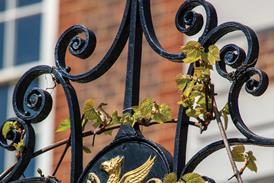Small law firms could face a hike of as much as 20% in professional indemnity insurance premiums later this year following a decision to double the minimum sum insured to £2 million.
At the same time, it has emerged that the few dozen worst-performing law firms that have failed to secure insurance are costing the profession millions of pounds in claims and unpaid premiums in the assigned risks pool (ARP).
The minimum sum has been £1 million for 15 years, and was proving too low in some cases, according to Peter Farthing, chairman of the Law Society's indemnity insurance committee, which proposed the change. He said £2 million would provide more protection to the public.
He said he did not foresee a rise in premiums in the current soft market. 'If insurers do not want the exposure, they can always reinsure the extra million.'
However, Sarah Clover, head of the solicitors' professional indemnity team at City firm Barlow Lyde & Gilbert, said: 'Sole practitioners and small firms will be the hardest hit by the increase in the minimum sum insured, because they only take out the minimum amount. This will mean higher premiums for them.'
A spokesman for St Paul Travelers said policies were likely to be more expensive but there were benefits to the public. He added that while St Paul would continue in the market, the extra exposure may deter some insurers.
Mike Rendell, founder of insurance broker Rendell & Partners, added: 'Traditionally, an increase from £1 million to £2 million would add 25-30% on the insurance premium, but the market has softened considerably in the last year. The larger insurers may well do the right thing and add on 20%, but I would not be surprised if some of the smaller insurers were to add on the extra million for free.'
The Gazette has learned that the estimated cost of the ARP, which is the two-year safety net for law firms that cannot find insurance, ranges from £7.5 million to £17 million for the first three years of its operation. There have been a few dozen firms in the ARP in any year, although this year it has dropped to just 19.
The ARP also covers those firms that slip through the net and practise uninsured, while the larger number of firms which fail to put insurance in place by the annual deadline also spend a short time in it.
It is a condition of being a qualifying insurer that each one underwrites the cost of the ARP in proportion to their share of the market, and they pass the cost on to the rest of the profession. The cost is mainly made up of claims the firms generate and premiums - which are punitive - that are unpaid.
Mr Farthing said the high-end £17 million figure accepted as true the amount sought by claimants against ARP firms, but added the ARP's cost 'is always going to look terrible' because it is the worst, uninsurable practices that are in it.
He said that between one-third and half of ARP firms rehabilitate themselves, while many others close and go into run-off covered by the pool. Premiums can be hard to collect as 'a substantial number of solicitors in the ARP are dead, bankrupt or in prison'.
Mr Farthing said the cost amounted to 1-2% of the amount paid by the profession in premiums. 'If we didn't have it, there would be a huge hole in public protection,' he said.
It has emerged that Mr Farthing's committee has agreed to changes sought by insurers to the aggregation clause. These could increase insurance costs for firms in mass litigation and mass conveyancing.
Multiple claims stemming from the same cause will be treated as one higher value claim, and the sum insured will need to be higher to cover the risk. Mr Farthing said: 'Firms should get advice on whether £2 million will be enough if they are doing the kind of work where many related claims could arise.'
He added that the move simply restored the position before a House of Lords judgment in 2003.
Changes to the minimum cover and aggregation have to be approved by the Master of the Rolls.
See guidance
Charity Explorer provides a reputable reference tool for solicitors, will-writers and their clients who want to leave a legacy or charitable gift.
Visit Charity Explorer
Whether you are looking for legal expert witnesses, legal training/CPD providers, international law firms, administration of estates, legal software suppliers, barristers chambers or any other general legal service, the Legal Services Directory will provide a suitable option.
Visit Legal Services Directory

























No comments yet